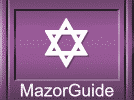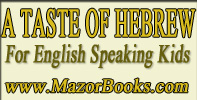Learning Hebrew and the Torah Reading
Hebrew is decidedly easier to read than English once you know it. In English
the looks like it should sound like ta-ha-eh, and enough would logically
be sounded out like ee-ne-oo-ga-ha, all the strange exceptions in English turn
it into a confusing language. Hebrew is almost completely phonetic. Combine the
letter and its vowel sound together, and youve got it.
Hebrew vowels are a little tougher. In English, vowels fit into the word itself,
like bat mitzvah has the a, i, and a inside the word. Using the Hebrew
vowel structure, the word would like more like this BaT MITZVaH. Vowels are
dots and dashes written underneath and above the letters. No vowels appear in
the Torah. Its a little hard, but definitely doable.
A special book, called a
Tikkun, is available with the verses as they appear in the Torah and the
same words in regular Hebrew type with vowels side by side. Practicing in a
Tikkun helps readers get ready for the vowel-free Torah.
A few weeks before the big day, schedule a viewing of the portion in the actual
scroll to get even more comfortable with how the words look and their layout. If
the reading will take place on Shabbat, practice with the shorter Monday or
Thursday morning Torah reading.
The Trop Torah Tune
Youll notice that the Torah is not just read, its chanted. The tune is ancient
and is indicated by dots, dashes, jagged zigzags, horseshoe shapes, and v-marks
above and below the words. These dont appear in the Torah scroll itself, but
they are in the
Tikkun and the Chumash, where the Torah text is printed in book form.







